Dreams come true not only at Gazprom. Thought about that when I stepped into the darkness of the test studio. The super line of JVC cinema projectors with 4K and 3D lurks enticingly in the rack. So that’s what you are, Hi End – in all black!.. In this review we are going to put aside the secondary things and focus on the main thing: the ergonomics and the visual evaluation of the image quality of top novelties. And in the following reviews we’ll dive deep into all the fine details and image parameters – on a metering and graphical level, for each model in JVC’s top-of-the-line X500, X700 and X900 ranges. In the meantime, our first impressions.
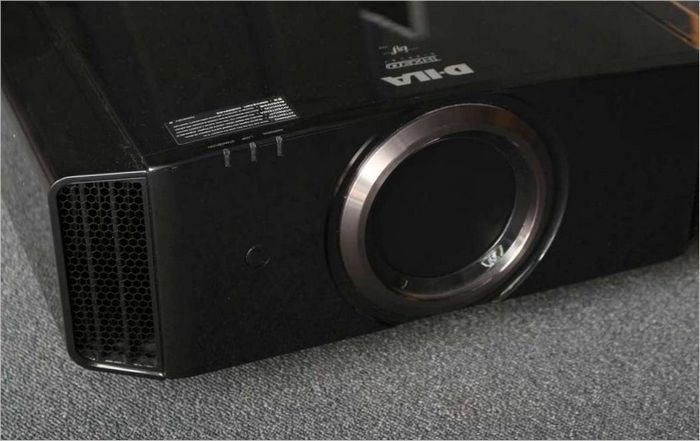
Package Contents
Let’s just say it’s not very basic, considering the price of the device – from 300 up to 700 thousand Dollars. In addition to all sorts of papers and the projector itself, it only comes with a remote control, a lens cover with batteries and a power cord.
You can accept the fact that you’ll have to buy 3D equipment separately. In the pictures is the sync box and the 3D glasses that are waiting for your money.
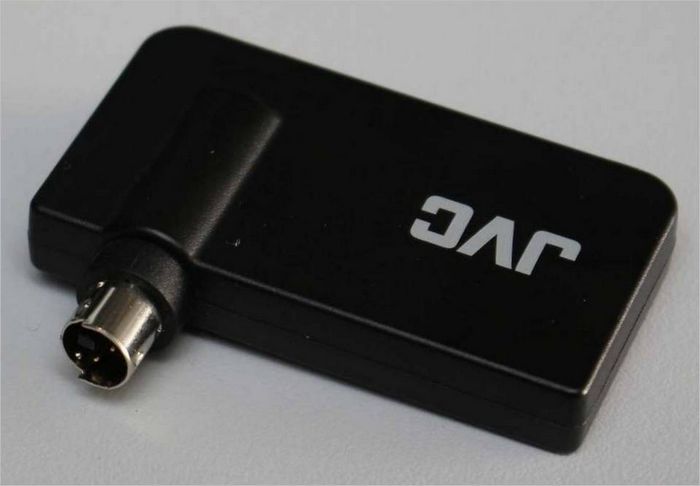
3D Synchronization Box
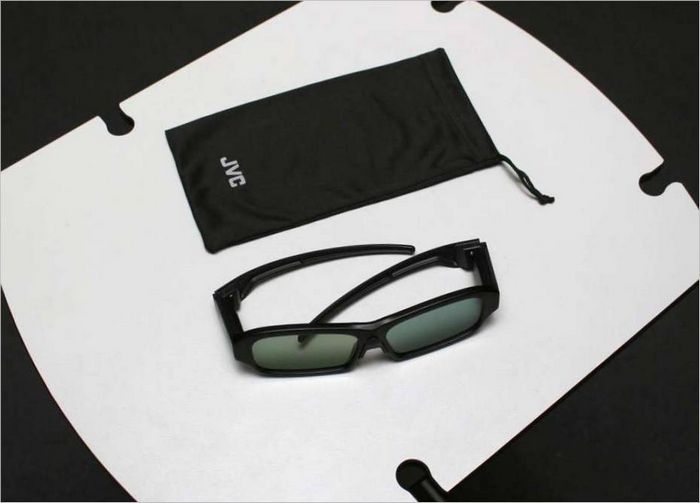
3D shutter glasses
At first I wanted to grumble along the lines of why not at least put an HDMI cable? And then I figured it out: the premium user will have even more cables from the previous Hi End. Or a new one ordered with diamond beads..
Ergonomics and connections
This kind of projectors are rarely visible to the user’s eye after installation. These are not the “luminaries” that are hung from the ceiling in classrooms. I think manufacturers are well aware of this too, price range and brand status oblige to make Hi End stylish. And JVC has it made.
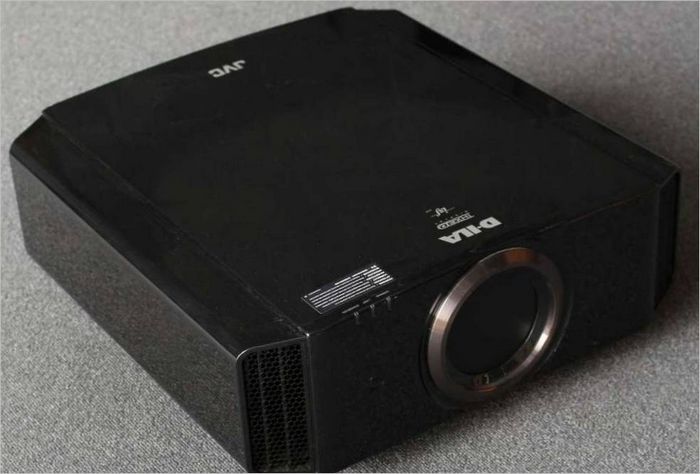
JVC DLA-X700RBE projector to the left eye
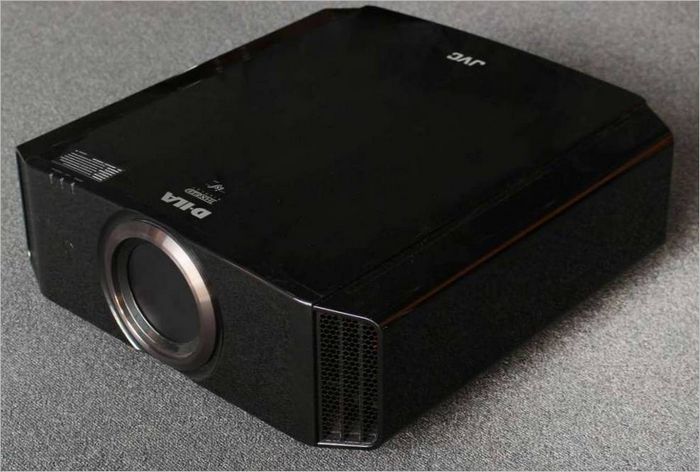
JVC DLA-X700RBE projector for the right eye
The case is a brutal, sleek brunette that can also be blond. JVC chose a clean and simple style to match the lines on the Mercedess G class. Nothing superfluous in the case – no curves, no buttons – complete symmetry. This is made possible in part because the lens control is motorized and does not require direct contact with the “all showing eye”.
The case also reminded me of a black drone, even the grilles for heated air look like space intakes… Maybe it’s not a projector at all, but a secret gizmo of extraterrestrial characters?..
If you go back to earth, the rest of the body is quite familiar: there are threaded feet to compensate for the horizon on which the projector is mounted. The height of the feet, unfortunately, is not so great, only 5 mm. And on the side of the lens – three LEDs, informing about the modes and status of the lamp. All connectors and a small manual control unit are located on the rear panel. The control unit is standard and basically repeats the navigation unit on the remote control, which we will talk about a little later.
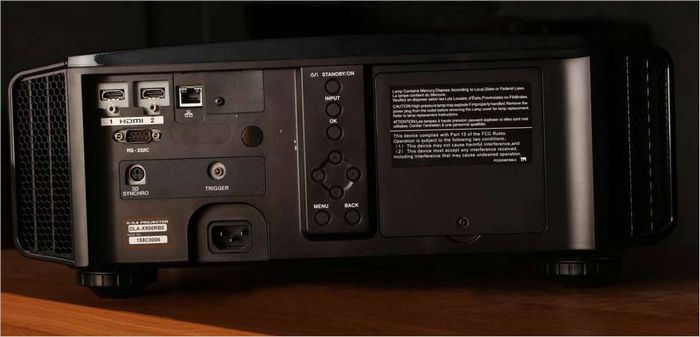
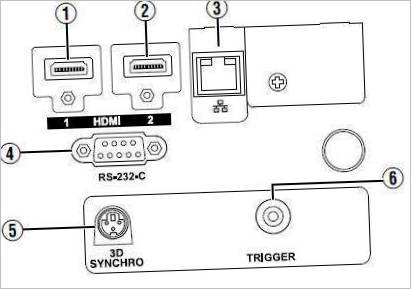
A set of connectors is quite ascetic. A pair of HDMI is designed for all video occasions – that’s pretty much it. Other connectors are not intended to receive video signal. RS-232-C and LAN ports allow the projector to be controlled from a computer. There is a port for sending commands, e.g. to a motorized screen or any other device. If you try your hand, you can make your own block to turn off the light when the projector is on.
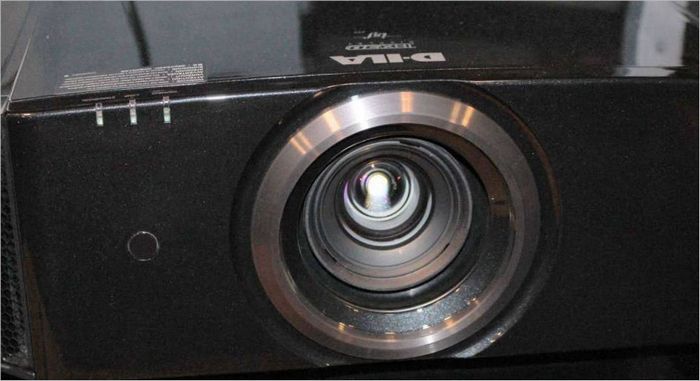
Lens possibilities
The lens deserves special attention – it is fully motorized. The lens has a 2x zoom and is equipped with a iris diaphragm. Projection ratio stated by the manufacturer 1.40 – 2.80 : 1. What it means?
Image width * Projection ratio = Projection distance
For example, if your screen is 0.6 m wide and the projection ratio is 1.8:1 which means 1.8 m projection distance for every meter of width , then the projector needs to be 0.6*1.8 = 1.08 m away from the screen.
From here I can present a table of distances for standard screen sizes: in the first column the image width, in the second column the projection ratio and the recommended distance to the screen.
|
118 cm |
1.65 m – |
3.30 m |
|
127 cm |
1.78 m – |
3.56 m |
|
144 cm |
2.02 m – |
4.03 m |
|
152 cm |
2.13 m – |
4.26 m |
|
169 cm |
2.37 m – |
4.73 m |
|
178 cm |
2.49 m – |
4.98 m |
|
203 cm |
2.84 m – |
5.68 m |
|
213 cm |
2.98 m – |
5.96 m |
|
221 cm |
3.09 m – |
6.19 m |
|
234 cm |
3.28 m – |
6.55 m |
|
244 cm |
3.42 m – |
6.83 m |
|
264 cm |
3.70 m – |
7.39 m |
|
295 cm |
4.13 m – |
8.26 m |
|
356 cm |
4.98 m – |
9.97 m |
|
400 cm |
5.60 m – |
11.20 m |
|
478 cm |
6.69 m – |
13.38 m |
|
503 cm |
7.04 m – |
14.08 m |
|
600 cm |
8.40 m – |
16.80 m |
With a large screen size, you must also have a decent-sized room to mount the projector at a sufficient distance.
The projector is very demanding on the side tilt. This slope must not be more than 5 degrees.

But the projector is less sensitive to vertical tilts and can tolerate up to +/-15 degrees.
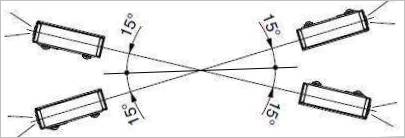
As for shifts, the projector compensates for them very well. Up to 34% horizontally and as much as 80% horizontally.
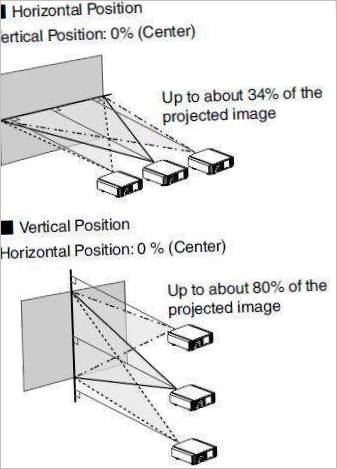
As for shifts, the projector compensates them very well. Up to 34% horizontally and up to 80% horizontally.
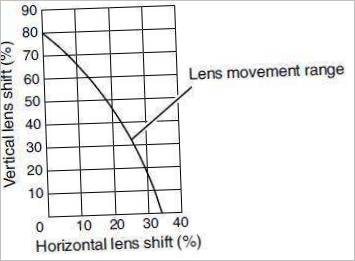
All this combined with excellent optics allows the user to feel comfortable and protected. Of course, it’s advisable not to use such optical compensation when installing the projector, but if there’s no choice, rest assured that the potential of the lens setup is more than enough
Remote control and menu options
Once the projector is installed in the right place, the only thing that will connect you with it is the remote control and the menu.
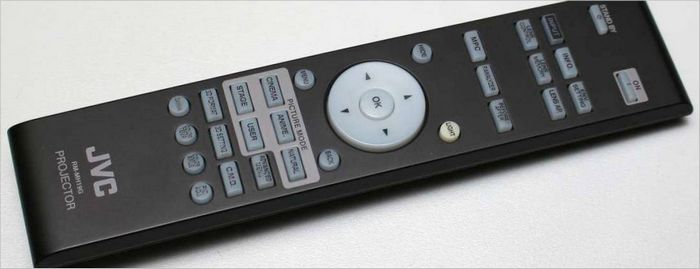
To make it easier to read the inscriptions on the keys, here is a picture from the manual.

The remote control is nice to the touch, well-balanced, backlighted keys. The latter, by the way, is a trifle, but very pleasant. Most likely you will have to work with the remote control in low light conditions. The main purpose of the remote, in my opinion, is to keep movie buffs from getting into the menu as much as possible. And the remote control copes with this task excellently.
On the top of the remote control there’s a standard set of buttons – power, standby, 3D settings 4 , Clear motion drive settings for fast moving objects 5 . The next row of buttons is dedicated to working with the lens and iris. It’s worth noting that the user doesn’t have to touch the lens with their own hands.
All adjustments including zoom and focus are motorized and can be changed through the remote control. Very nice that there is a memory for storing lens settings. Then comes the navigation box, everything is standard here.
The picture mode block contains not only the mode button, but also offers you a separate button for each mode. It is very convenient, because you do not need to get into the menu, or worse – to press the same button several times, scrolling through all modes in a row, cursing at your life and accidentally go to the second round of search.
The purpose of button 21 is not clear to me, pressing it will scroll the following chain: picture mode -> color profile -> color temperature -> gamma. Exactly the same, but without going round and round you can do with the help of the keys 21-25.
By the way the last buttons are the most interesting: quick access and access to these kind of settings in general is very important for adjusting the picture quality. Gamma, color temperature and color profile are basically all components of a perfect picture.
Let’s see what the menu allows in the picture settings. I will not dwell on such basic things as switching between 16:9 and 4:3, setting inputs, keystone control, lamp power settings, etc.d. If before any of these things could surprise you, now it’s the bare minimum that’s out of the question.
What I’d like to pay attention to is a great opportunity to calibrate the image. Frankly speaking I didn’t expect that, but first things first.
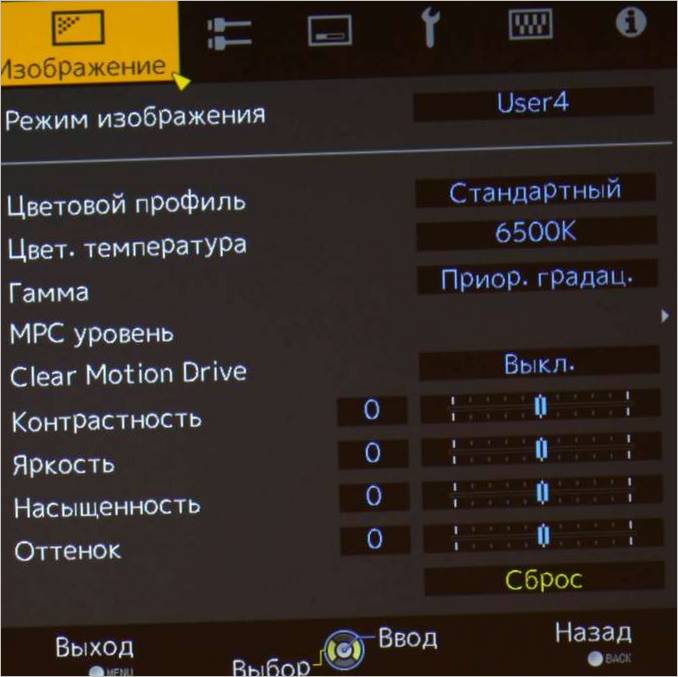
The picture setup menu window is not very different from the ones I have seen before. The main bonuses are hidden inside.
You can set the color profile in many ways.

However, most of them are available only in user mode. Note that you can take the color profile of any of the modes as the basis for the custom mode.
The choice of color temperatures is no less rich: Kelvin settings from 5500K to 9500K 9 steps , several xenon options. But the most interesting thing is the manual adjustment of color temperature. And the manufacturer offers us not only the standard Temp and Tint. The user can adjust each of the RGB channels by gain and offset independently for light and dark areas of the image.
This opens up a huge opportunity to adjust color temperature. Using this approach, you can correct, for example, too warm shadows or, conversely, too cool highlights. With standard Temp and Tint this is impossible to do, because by “cooling” the shadows, we automatically make the highlights even cooler.
The gamma adjustment options have gone even further. To tell the truth, I did not like the fact that the manufacturer substituted the numerical values of gamma for the names. For example, the priority of gradation, the priority of contrast, etc.d. It may be convenient for someone, but personally for me it is not. But all of this is compensated for by the CHANNEL GAME SETTING !!!
You heard right, the projector allows you to adjust each channel’s gamma curve.
I like to say, manufacturers, I love you. With these settings and colorimeter you can calibrate the projector perfectly, and not only with your computer, but also with blue-ray player or anything else. Without such settings, such sophisticated calibration is only possible using profiling, and that requires output from a computer.
There are only three points for the gamma ray settings, general brightness, shadows and highlights. Of course, we would like to have more points and more precise markings, for example, 0%, 25%, 50%, 75% and 100%. But even this is a blessing for a knowledgeable person.
So the calibration capabilities of the projector are really impressive. However, let’s not forget that the main thing with such an abundance of settings is not to make it worse, and it’s pretty easy to do. Let’s follow the rule of mushroom hunters – don’t know, don’t touch.
Visual assessment
Visual assessment of the image quality was performed under ideal conditions – neutral walls, complete darkness and a huge, high-quality screen. You can’t imagine how much fun we had during the testing process.
A “toy” is not a cheap one, that is why the requirements to the quality of images formed by it are very high. I made my first positive impression before we started looking at photos and movies.

Oddly enough, it was a Kaspersky label no, this is not hidden advertising! on my desktop it looked like something out of a Levitan painting… deep red, contrasty… all indicative of the projector’s advanced color gamut and probably a very good gamut.
The picture as a whole is very bright, the lamp power is more than enough to work even in bright outside light. Although, of course, then the accuracy of color reproduction and gamma is out of the question without calibration.
The projector offers quite an exotic choice of modes, and the names of some modes are especially shocking and positively shocking: Old Film, Movie, Animation, Natural, Photo, Variety, THX, Custom 4 pieces .
While some of the modes are standard and have certain requirements, some are completely incomprehensible to me. For example Photo – wide color gamut, right gamma, color temperature close to 8500K. Variety, old movies, animation – um… I can’t even imagine why there should be such a variety.
As a base for the visual test, I chose the Custom mode with the Adobe RGB color space setting. Because this mode originally had a standard color gamut, and I wanted to use the projector’s full potential.

The projector coped very well with the shadow test. Black was right on black. Interesting how the projector behaves when displaying a totally black image on the screen – it has NO light flux at all! This made it possible to make black truly black, as in a black hole.
The pebbles had a slightly lukewarm hue, as they should be. Reflection of color shades in the dark areas of the image is really not an easy task for a projector. The Milky Way shone very clearly. The milky image also allowed us to gauge what the sharp transitions would look like, from almost black sky to almost white stars. I didn’t notice any visual problems with it. The transitions were crisp, so the stars looked very sharp.
This time we decided to add to the review one of the pictures which illustrate skin tone – the color of a person’s skin, which can be very different – from black to almost white.
For Europeans, the characteristic shades are pinks, reds, yellows, sometimes browns. In other words, color can be very different, but agree, even if you don’t know the person from the photo, you can tell to a certain extent if the color is correct.
The presence of green, blue shades will immediately tell you that there is something wrong here, the projector is lying a bit. Moreover, proper skin tone rendering implies smooth transitions. Somewhere the face is darker, somewhere lighter and the projector should make these transitions smoothly, without extraneous shades.
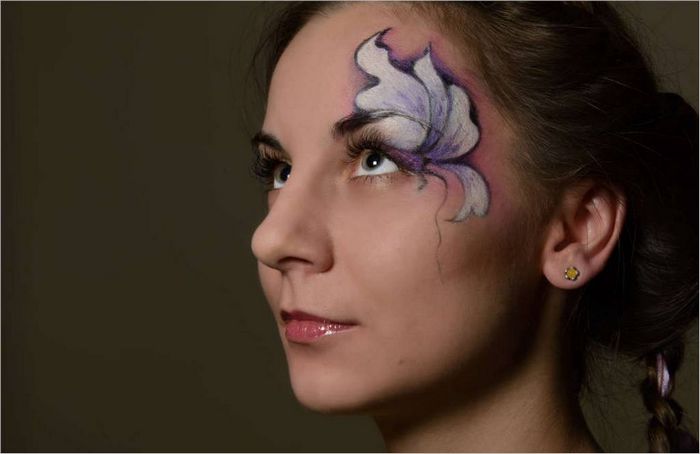
The projector we tested did a great job. Transitions were smooth and the detail was amazing. Tones are warm and extremely pleasing to the eye. The picture looked more like an analog film photograph than a digital one.
Besides, this picture allows to estimate the presence of pasteurization. The background has a smooth and very slight transition from one shade of brown to another. All this causes the risk of seeing the transition boundary. This kind of artifact can be seen, for example, in low-quality video, especially on a cloudless sky. Though why create intrigue, this is not and can not be such a problem with the projector of Hi End class.

The next photo is designed to appreciate the medium tones of the image. In addition, you can appreciate the light shadows and highlights in the sky and clouds expressed here. The foreground, which was in shadow, looked very good. I could clearly make out all the tonal gradations on the pebbles and grass.
The color of the water was just unimaginable, like I was back in the scene m. Brussa, Khasan district, Primorsky Krai . The water is really turquoise and crystal clear there and the projector provides a full presence effect. First of all it is a merit of extended color gamut, which, let me remind you, we turned on during the testing.
As for the light areas of the image, there are no serious complaints about them. The transition in the sky is smooth. The clouds don’t look puffy, and the detail in the clouds is clear. The transition between the really sunken areas and the areas where there is detail is not conspicuous. This shows a good gamma curve in the light areas of the image.

And since we’ve chosen the extended color gamut of Adobe RGB, I couldn’t deny myself the pleasure of picking out a picture with a lot of green. Exactly in green tones, Adobe RGB is much wider than sRGB. Moreover, as I wrote earlier, green is the most important color in the RGB model link to article .
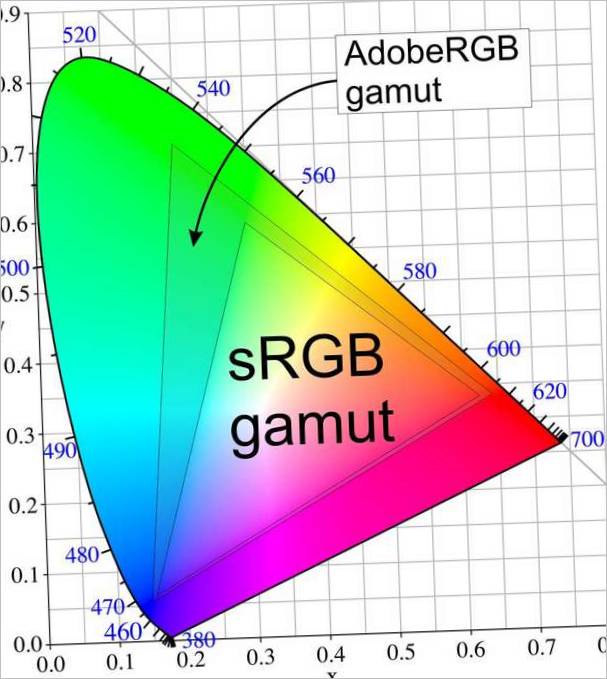
If you’re reading this on a normal monitor, you’re probably wondering what kind of picture this is, you know, just some obscure green? But if you watched it on a monitor with an augmented color gamut, you could sense the presence, the realism, the richness of the image.
Not only does the projector provide a deep green like all the others , but it also does a great job of separating the hues. In our case, many parts of the blurred background could look like absolutely the same, single-color. This is not a problem with the projector. That says that the accuracy of the other colors is very good.
Where’s the connection between the colors, you ask?? Believe me, it does. Here’s the thing: In order to get the shades of green, some other colors are mixed in with the green. If the mixing is inaccurate, the final result will not be what we see.

The image of an autumnal dawn was used to estimate the color temperature. There are both cool areas here, like the fog on the left side, and warm areas, the morning dawn. Somewhere in the center of the image there is a transition from warm tones to cool tones. It feels like the color temperature was perfect, the transition was where it needed to be. Warm was warm, cold was cold.
3D image
We chose “Gravity” as our test film to evaluate the 3D picture. It was one of the few times I enjoyed watching 3D.
I won’t hide the fact that I don’t like 3D, I think the technology in this area is crude. I personally feel uncomfortable watching 3D pictures most of the time. I remember when we tested another famous brand projector I didn’t get any pleasure from 3D video because I could feel flickering in my glasses and it strained my psyche. I only think about the flicker, not the movie.
JVC isn’t without this flaw either, as the shutter glasses technology is similar. However, the effect of this flicker is several times lower! It is not conspicuous, you can watch a film in total peace.
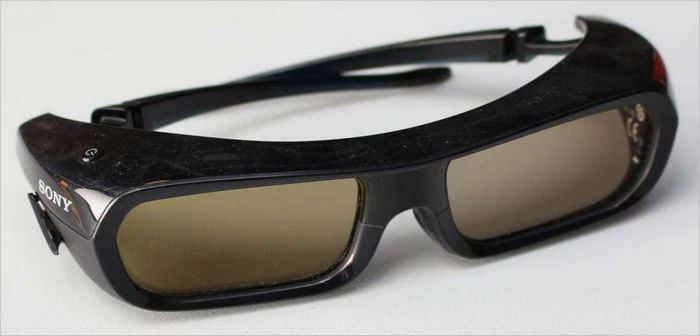
The glasses absorb a little bit the brightness and richness of the picture, but this is an objective reality, there is no other way at this stage of technology. So if you’re a 3D fan, I highly recommend the JVC X series projector.
Now let’s talk about eShift technology and how it works in practice. I would say it’s very good interpolation technology. There will be no new details, say, on human skin from virtual 4K, of course. But you won’t see pixels on the screen under any pretext.
But eShift is very sensitive to the quality of the content. Since it is a magnification, the defects in the image increase together with it. Particularly critical is the digital noise. If the video content is not very high quality – like 6 in one, it’s better to disable eShift mode. Although, of course, the technology is very original and more than working on a good video.
You can also use dynamic movies as an example to see how clear motion drive works. I personally have no complaints about its performance. I can immediately see the difference between on and off. and off. You don’t have to look closely and look for the differences.
As for the intensity of this technology, which is offered to choose from, this is a subjective matter. I liked the Low level the most. But maybe on another movie, like some fighting game, it won’t be enough.
And if you put your nose to the screen?
While watching static images, I noticed that some of the pixels kind of shake. Not in the sense that they moved, but in the sense that they changed color a bit. It’s hard to describe it in words. It looks more like a dark sky in a low-quality movie, there is some random noise when you look closely, but the color of the sky seems to be in general visually unchanged.
I’ve seen something similar in very small volumes here as well. However, you practically have to put your nose against the screen to see pixel trembling, so we won’t pay attention to such faults.
Conclusion
The ergonomics of the remote control and the menu are excellent. The calibration possibilities are amazing and allow you to calibrate the projector to almost any signal source and environment
Very pleased with the really working technology eShift and clear motion drive. I’m very glad that this is not the nonsense of marketers a couple of patent this phrase! , and the really cool stuff.
Talking about the visual evaluation, this device is on the first place in my personal ranking of the projectors I have tested.
The picture is bright and juicy. The details in shadows and highlights are not lost. As for the overall contrast, it’s on point and the picture looks very natural.
I was not able to detect any parasitic shades and other color defects. Color temperature is normal. 3D enthusiasts will be able to fully enjoy the viewing experience without experiencing the discomfort of the current level of 3D technology. All in all, in terms of a visual test, I don’t even know what to pick on.
As you know, a product has several characteristics by which it can be bought. Pricing, brand marketing, advertising and technology features. It is pleasant that in contradistinction to Arrle products the main JVC direction is not marketing, but the combination of engineering and price policy.

These projectors sound impressive! Can you provide more information about their virtual 4K capabilities?
These JVC DLA-X projectors sound impressive with their virtual 4K technology! I’m curious to know more about how they have gotten cooler and closer to people. Can you please elaborate on any specific features or advancements that make them stand out?